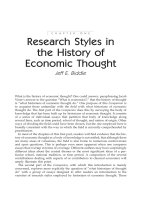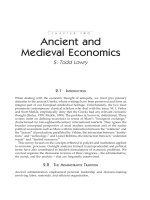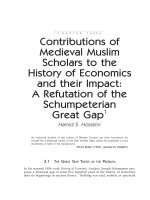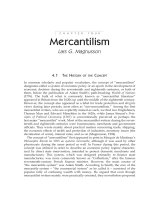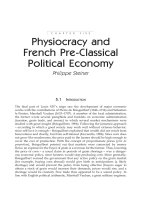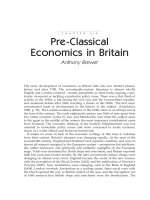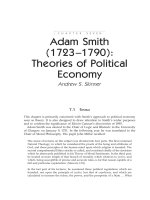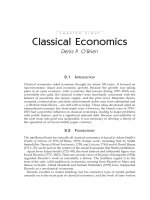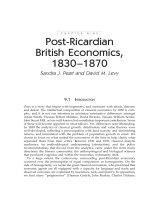A Companion to the History of Economic Thought - Chapter 3 pptx
Bạn đang xem bản rút gọn của tài liệu. Xem và tải ngay bản đầy đủ của tài liệu tại đây (219.52 KB, 18 trang )
28 H. S. HOSSEINI
CHAPTER THREE
Contributions of
Medieval Muslim
Scholars to the
History of Economics
and their Impact:
A Refutation of the
Schumpeterian
Great Gap
1
Hamid S. Hosseini
No historical student of the culture of Western Europe can ever reconstruct for
himself the intellectual values of the later Middle Ages unless he possesses a vivid
awareness of Islam in the background.
Pierce Butler (1933), quoted by Mirakhor
3.1 THE GREAT GAP THESIS AS THE PROBLEM
In his seminal 1954 work History of Economic Analysis, Joseph Schumpeter pro-
poses a historical gap of some five hundred years in the history of economics
after its beginnings in ancient Greece. “Nothing was said, written, or practiced
CONTRIBUTIONS OF MEDIEVAL MUSLIM SCHOLARS 29
which had any relevance to economics” (Mirakhor, 1988 [1983], p. 301) within
this “historical gap,” which stretched from the demise of Greek civilization to the
writings of Thomas Aquinas (1225–74). For, according to Schumpeter (1954,
p. 74), many centuries within that span are blanks. Emphasizing the contribu-
tions of Thomas Aquinas, which, to Schumpeter, were instrumental in ending that
five hundred years of “historical discontinuity,” the author of History of Economic
Analysis writes: “so far as our subject is concerned we may leap over 500 years to
the epoch of St. Thomas Aquinas (1225–74) whose Summa Theologica is in the
history of thought what the South-Western spire of the Cathedral of Chartres is
in the history of architecture” (Schumpeter, p. 74).
According to Schumpeter, what distinguished the thirteenth century from the
twelfth, eleventh, and earlier centuries was the revolution that took place due
to Aquinas and the Scholastics in theological and philosophical thought. This
revolution, Schumpeter maintains, had two causes: the rediscovery of Aristotle’s
writings, and what he calls the towering achievements of St. Thomas Aquinas
(Schumpeter, p. 87). De-emphasizing the first cause, Schumpeter writes that: “The
reader will observe that I do not assign to the recovery of Aristotle’s writings the
role of chief cause of the 13
th
century developments” (Schumpeter, p. 88).
Adherence to the Schumpeterian Great Gap thesis has by no means been
restricted to Schumpeter’s 1954 book. As several writers – Mirakhor, Essid,
Ghazanfaar, Islahi, and Hosseini – have demonstrated, the thesis, which ignores
the contributions of medieval Muslim scholars, has been “deeply entrenched” (at
least until recently) as part of the accepted tradition among historians of eco-
nomic thought. Although it became more explicit and was perhaps strengthened
by Schumpeter’s History of Economic Analysis, the thesis was well established in
the nineteenth century, as is evident in William Ashley’s 1988 book on the his-
tory of economics. According to Ghazafar, “Even Jacob Viner, proclaimed by
Blaug as the greatest historian of economic thought that ever lived, unhesitat-
ingly accepts the gap thesis” (Ghazanfar, 1995, p. 241). In fact, in a review essay
on Schumpeter’s History of Economic Analysis, Viner simply accepts the “gap” and
acknowledges Schumpeter’s claim of having accounted for “every writer who
made a significant contribution to the development of economic theory” (quoted
by Ghazanfar, 1995, p. 241). Whatever his reason, Viner, like Schumpeter, also
ignores Islamic contributions to economics during the blank centuries (ibid.). Of
course, the same can also be said of the texts in the history of economic thought,
at least until recently.
The Schumpeterian Great Gap thesis is problematic, for there was no historical
discontinuity in those “blank” centuries; it is certainly not true that “many centur-
ies within that span are blanks” (Schumpeter, p. 74). Furthermore, the Thomasian
revolution suggested by Schumpeter was a reaction to the Greco-Islamic influ-
ence in the Latin West and was impacted by it.
Notwithstanding Karl Polanyi’s substantive and formalistic distinctions in
economics, it is a fact that many non-Western civilizations made contributions to
the development of economics within those “blank” centuries (Hosseini, 1995,
p. 539). This is particularly true of medieval Muslim scholars – theologians,
jurists, Greek-inspired philosophers, and authors of the (Persian) mirrors for
30 H. S. HOSSEINI
princes. Those writers – who reflected Greek rationality, a sense of realism and
practicality characteristic of the Persian-originated mirrors, the worldly teachings
of Islam, and the “modernistic” economic institution present in medieval Islamic
society – produced theories closer to the economic concepts of the more recent
centuries than those of the Greeks or pre-modern Latin Christianity. That, of
course, occurred before economics had become an independent discipline.
Medieval Muslims also influenced Christian scholasticism and Thomas Aquinas
in their economic views, another point also neglected by Schumpeter and other
historians of economics. For scholasticism was a form of ecclesiasticism that
contained various elements, including Islamic thought (Mirakhor, 1988 [1983],
p. 304). Furthermore, medieval Islamic influence in economics may even have
extended to centuries beyond the age of Thomas Aquinas, as Hosseini has demon-
strated in his paper on the division of labor (Hosseini, 1998, pp. 653–81).
Interestingly enough, Latin Scholastics had initially found Islam and the
philosophic works of Muslims to be threats to Christian dogma (Ghazanfar,
1991, p. 130), evidenced by over two hundred condemnations, called Averroestic
heresies, published by the then Bishop of Paris. The numerous translations in the
eleventh, twelfth, and thirteenth centuries into Latin of the works of Muslim and
Greek philosophers were so different from Christianity that, in the words of Will
Durant, “they threatened to sweep away the whole theology of Christiandom
unless Christianity could construct a counterphilosophy” (quoted by Ghazanfar,
1991, p. 130). To overcome that fear, Aquinas used the views developed by the
prominent (Persian-speaking) medieval Muslim theologian Ghazali. For in writ-
ing his book The Incoherence of Philosophers (1927), Ghazali had placed science,
philosophy, and reason in a position inferior to religion and theology. According
to Meyers, the Scholastics accepted this view of Ghazali and made it a character-
istic of much of their philosophy (Ghazanfar, 1991, p. 130). The works of Ghazali
and other prominent Muslim scholars had been translated into Latin before 1150.
Muslim scholars were also instrumental in the transmission of Aristotelian
ideas to the Latin West, a point also ignored by Schumpeter. Jourdain’s study of
the scholars of the eleventh and twelfth centuries found not even “a single passage
to suggest any of these authors suspected that the pursuit of riches, which they
despised, occupied a sufficiently large place in national as well as individual life
to offer to the philosopher a subject fruitful in reflection and result” (Mirakhor,
1988 [1983], p. 308). It is well documented that all of the European scholars
mentioned in chapter 2 of Schumpeter were in fact influenced by Muslim thinkers
(Hosseini, 1998, p. 675).
The following sections will discuss the contributions of medieval Muslim
scholars, the causes and roots of those contributions, and their impact on Euro-
pean scholasticism. We will also explore the reasons why these contributions have
not been acknowledged during the past few centuries. We will, however, discuss
first the significance of Joseph Spengler’s 1964 path-breaking article on Ibn Khaldun
(1332–1406). But, because Spengler’s 1964 article failed to prove the historical
continuity of economic thought and thereby refute the Schumpeterian thesis in
its totality, we will also discuss the impact of the more serious challenges to the
gap thesis that emerged later on.
CONTRIBUTIONS OF MEDIEVAL MUSLIM SCHOLARS 31
3.2 JOSEPH SPENGLER’S 1964 ARTICLE: OVEREMPHASIZING THE
GREEK ELEMENT IN ISLAMIC ECONOMIC THOUGHT AND MORE
Joseph Spengler’s 1964 article dealt the first blow to the Schumperian Great
Gap thesis, without even mentioning it. By writing this article, Spengler became
the first Western historian of economics to acknowledge the contribution of a
“medieval” Muslim thinker and to view it as significant. For Spengler believed
that, among other things, Ibn Khaldun “had a deep insight into the essentials of
the accumulated knowledge of his time, could evaluate the manifestations of the
culture of his day, could reflect faithfully the understanding which contemporary
lawyers and jurists had of practical economic and financial matters that normally
were not treated in books” (Spengler, 1964, p. 269).
Spengler’s article, while important in acknowledging the neglected contributions
of various Muslim scholars, was not without its share of problems. According to
Mirakhhor, “Perhaps due to his zeal to show the influence of Greek writings on
Muslims, which he does on every page of the first section of his paper, Spengler
only considered some of the available evidence from the ninth century onwards”
(p. 309).
While we cannot deny the impact of Greek thought on Islamic civilization – for
the latter is a confluence of Arab, Greek, and Persian (i.e., Iranian) elements – we
should at the same time not overemphasize the share of individual components
in that synthesis. However, by exaggerating the Greek share in that totality,
Spengler diminishes the extent of the contributions of the pre-Ibn Khaldun Muslim
scholars that he surveys: “Such attention as was given to theoretical economics
seems to have been prompted less by an early and persisting interest in taxation
than by contact with Greek philosophical and scientific writings, especially those
of later Platonic and neo-Platonic orientation” (Spengler, 1964, p. 270).
Spengler, being aware that Ibn Khaldun’s knowledge of economic behavior
was superior to that of Bryson of Heraclea and other Greek thinkers, fails to
understand that Ibn Khaldun’s substantial knowledge of economic matters
reflected the realities of medieval Islamic society and the knowledge of many
Muslim scholars of the “Gap” centuries.
Furthermore, by concentrating on the contributions of Ibn Khaldun – who
lived after the Schumpeterian blank centuries – Spengler, in effect, did not pro-
vide sufficient ammunition to negate the Schumpeterian Great Gap thesis;
Spengler’s article was not in total support of the historical continuity of economic
thought, although it was a step in the right direction. In addition, by overemphas-
izing the impact of Greek thought, Spengler downplayed the contributions of
Muslims who were not affected (at all or very much) by Greek thought. He also
ignored the contributions of those scholars who wrote during the first two and a
half centuries of Islamic history, since it was some two and a half centuries after
the rise of Islam that the works of Greek thinkers were translated into the Arabic
language.
In spite of the significance of the 1964 path-breaking article by Spengler, the
real challenge to the Schumpeterian Great Gap thesis came about as a result of the
32 H. S. HOSSEINI
work done by a few economists with roots in Muslim lands (although the work
of the Belgian economist Leuis Baeck and the personal encouragement of Todd
Lowry should not go unnoticed). These historians of economics, in addition
to demonstrating the contributions of medieval Muslim scholars, also chal-
lenged the accuracy of the Schumpeterian thesis, and tried to show the impact of
medieval Islamic scholarship on Aquinas and Christian scholasticism.
3.3 ECONOMIC ACTIVITY IN MEDIEVAL ISLAM
Jourdain’s observation (above) was indicative of the medieval Christian scholars’
disapproval of the pursuit of riches. The Greeks too were less approving of the
pursuit of riches than medieval Muslims. In Plato, we see a derogation of eco-
nomic activity, reinforced by his description of the property arrangements for
each class. For him, only the lowest classes – farmers and artisans – were allowed
to work for profit and accumulate property; the pursuit of money by the base
would not arouse the envy of wise rulers more than the prudent exercise of
power by the latter would antagonize artisans and farmers (Hosseini, 1998,
p. 66). And, as stated by McNulty (1975), for Plato, the desire to engage in ex-
change is not a universal human characteristic; rather, it is a specialized activity.
This view is obvious in the Republic, in the discussion between Socrates and
Adiemantus. Plato rejected private property, at least for the upper class, because
it causes selfishness. Although Aristotle defended private property, he rejected
exchange and had no Platonic appreciation of the division of labor (Hosseini,
1998, p. 66).
Medieval Muslim scholars viewed wealth and gainful activity more positively.
This was partly because Islam had mercantile roots. It is worth mentioning that
the Quran (believed by Muslims to be the direct words of God) and the Hadith
(reported words and acts of the Prophet) have a negative view of what the Quran
calls Riba (interest, or as some argue, only excessive usury). However, these two
highest sources of Islamic law regard wealth and profit, on both exchange and
productive activity, very positively (Hosseini, 1988, p. 58).
In the Quran and the Hadith, production and trade are viewed as noble prac-
tices (Essid, 1987, p. 78). (In contrast, the medieval Christian Church was insisting
that no Christian ought to be a merchant.) According to Sami Zubaida, “The
Meccan milieu of Mohammad and his followers was a business milieu. Before
the call to Islam, Mohammad and his companion engaged in trade extensively.
Mohammad was a relatively small merchant, but also worked as agent for other
merchants in trade with Syria. The early Muslims of Mecca and Medina con-
tinued in trade” (Zubaida, 1972, p. 321).
According to Maxime Rodinson, in medieval Islamic society, “the capitalist
sector was undoubtedly well-developed in a number of aspects, the most obvi-
ous being the commercial one” (Rodinson, 1978, p. 28). According to Nasser
Khusraw (1003–60) – a Persian poet, essayist, and traveler – in the year 1052 there
existed in the central Persian city of Isfahan some two hundred money changers,
although usury is forbidden in Islam (see Hosseini, 1995, p. 543). Many economic
CONTRIBUTIONS OF MEDIEVAL MUSLIM SCHOLARS 33
historians – such as Udovitch (1970), Labib (1969), Tuma, and S. G. Goitein –
have elaborated on these aspects of medieval Islamic society. These writers have
demonstrated attempts by early Muslim leaders at enforcing fiscal and monetary
policies, deficit financing, the use of taxation to encourage production, and the
existence of credit and credit instruments for the rudiments of checking and
saving accounts, banking institutions, and procedures for the formation of part-
nerships, commendam contracts, and monopolies, all of which developed before
the ninth century. By the ninth century, these developments had been enshrined
in Islamic law (i.e., figh manuals).
According to S. G. Goitein: “A subject worthy of such special study is the mer-
chant class and bourgeoisie of early Islam. This class developed slowly during
the first hundred and fifty years of the Muslim era, emerged into the full light
of history at the end of the second, became socially admitted during the third
and asserted itself as a most powerful socioeconomic factor during the fourth”
(Goitein, 1957, p. 584).
Of course, the early Islamic bourgeoisie was not able to obtain political power,
nor was it able to enjoy other powers necessary to become as effective as the
type that eventually emerged in Western Europe centuries later. This is because
this early bourgeoisie “never became an organized body and, as a class, never
obtained political power, although many of its members occupied positions as
the highest executives of the state” (Goitein, 1957, p. 584).
As stated by Goitein, “Before all this happened, however, Islam as a religion
and civilization, had fully taken shape, and it was largely members of the bour-
geoisie, who had developed Muslim religious law, which is the backbone and
very essence of Islam” (Goitein, 1957, p. 584).
3.4 ISLAMIC VIEWS OF THE ECONOMY AND ECONOMIC POLICY
PRIOR TO THE NINTH CENTURY
Medieval Muslims had already held and expressed a positive view of economic
activity before the ninth century, when the Abbasid Caliph Maamoun ordered
the translation of the works of the Greeks into Arabic. In fact, numerous scholars
and jurists had written on economic issues, almost from the inception of Islam
(Mirakhor, 1988 [1983]; Ghazanfar, 1991; Hosseini, 1995).
Prophet Mohammad is reputed to have said that the state should have only a
limited role in the productive process, in market structure, and in the movement
of prices. According to Elias Tuma, the role of the state “was restricted to factors
which distorted normal conditions, these being competition and price determina-
tion through invisible forces such as God’s will and the interaction of supply and
demand. However, when intervention by the state was deemed necessary it
was usually kept at a minimum and exercised through the market” (Tuma, 1965,
pp. 10–18).
Mohammad, as the prophet and political leader of the Islamic community,
refused to combat price rises by direct action, stating that only God alone sets
prices (i.e., invisible hand? – see Tuma, 1965, p. 14). Mohammad is believed to
34 H. S. HOSSEINI
have declared that one who supplies the market with a commodity receives his
income as a blessing, but the monopolist who withholds his supplies receives his
income as a curse (Tuma, 1965, p. 15).
Among the pre-ninth-century Muslim scholars endowed with a deep under-
standing of economic issues and matters, the Iraqi jurist Abu Yusuf (731–98)
stands out. Having studied Islamic jurisprudence under Abu Hanifah (founder
of the Hanafi Sunni School of thought), Abu Yusuf, a judge for several Abbasid
Caliphs, was eventually chosen by Abbasid Caliph Harun al-Rashid as his chief
jurist (Qadi al Qudat) in Baghdad, the capital. It was in his capacity as chief jurist
that Abu Yusuf composed The Book of Taxation (Kitab al-Kharaj), addressing
Caliph Harun al-Rashid. In this volume, the eighth-century jurist exhibits his
understanding of taxation, public finance, agricultural production, and other
related economic issues (Ghazanfaar, 1991, p. 125; also see M. N. Siddiqui, 1964;
S. A. Siddiqui, 1968). In Kitab al-Kharaj, Abu Yusuf shows his preference for a
proportional tax on agricultural produce, instead of a fixed rent on land. He
finds a proportional tax on agricultural produce more just and, at the same
time, as providing a greater incentive for bringing more land into cultivation,
thus creating more revenues for the government. Abu Yusuf strongly opposes tax
farming – a practice by which the tax collector could confiscate land in case of
delinquency (Ghazanfar, 1991, p. 5). Interestingly enough, this eighth-century
Muslim jurist suggested certain principles that anticipated those proposed 1,000
years later by Adam Smith (1985 [1776]) as the four canons of taxation; namely,
equity, certainty, convenience, and economy. As a result of these principles and
to ease the burden of taxes on taxpayers, Abu Yusuf proposed the ability-to-pay
principle of taxation and convenience regarding time, space, and the manner of
payment of these taxes. Furthermore, to reduce the likelihood of corruption in
the collection of taxes, Abu Yusuf proposed a centralized tax administration and
the use of strictly supervised salaried workers as tax collectors.
Abu Yusuf also provided a deep insight into issues such as the distribution
of tax revenues, government responsibilities concerning societal welfare, the
promotion of economic development, and the building of socioeconomic infra-
structure and public works such as roads, bridges, and canals for irrigation
or transportation purposes. He also discussed various types of taxes, including
specific taxes on commodities, death taxes, and import duties, and problems
related to water supply, fisheries, and forest and pasture lands.
Concerning private projects and state responsibilities, he writes: “As for smaller
canals from which people obtain water for their own farms, fruit orchards,
vineyards, vegetable gardens, etc., the expense of cleaning and restoring them
should be borne by the residents themselves. There should be no burden on the
state treasury” (Kitab al-Kharaj; quoted by Ghazanfar, 1998, p. 22).
To Abu Yusuf, no part of the expense should be borne by the taxpayers if the
project benefits the entire Muslim community.
CONTRIBUTIONS OF MEDIEVAL MUSLIM SCHOLARS 35
3.5 MEDIEVAL MUSLIM CONTRIBUTIONS TO THE HISTORY OF
ECONOMICS BEYOND THE EIGHTH CENTURY
Although scholars in the first two and a half centuries of Islamic history demonstr-
ated a thorough understanding of the economy of their age, their understanding
of the economy was enhanced when they witnessed the rise of non-Islamic
thought in their midst. Islamic understanding of economic matters benefited
from the works of Greek masters, and the mirrors of Persian origin which were
translated into Arabic.
2
Philosophy entered Islam when, during the ninth century, the Abbasid Caliph
Maamoun ordered Syrian Christians at Baghdad to translate the works of the
Greeks into Arabic. These translations gave rise to a great deal of philosophic
activity and some of the greatest philosophers in history, who debated,
reproduced, added to, and wrote commentaries on the philosophic works of the
ancient Greeks. The first Greek-inspired Muslim philosopher was (Arab) Al-Kindi
(d. 870), who was soon joined by many others, mostly of Persian origin.
However, even before Al-Kindi, a rationalist Islamic “philosophic school” – the
Mutazeleh school – had emerged, peaking when scholar Abd al-Jabbar composed
a volume in dialectical form.
The Islamic mirrors for princes literature was “an important and characteristic
branch of Persian belles letters” (Lambton, 1980, p. 449). It entered Islamic thought
when the Iranian Ibn Muqaffa (724–57), a Zoroastrian convert, translated four
Persian (of pre-Islamic Sassanid-age) books of moral counsel into Arabic, and
wrote two more mirrors in Arabic himself. Soon Ibn Muqaffa was joined by
numerous other writers who – writing in Persian, Arabic, and other Islamic
languages – produced a branch of thought that was rich in an understanding of
economic activity (Hosseini, 2001).
The availability of Persian and Greek sources in Arabic, the language of intel-
lectual discourse among all scholars of medieval Islamic society, introduced these
scholars to the issues (economic or otherwise) debated by ancient Greek thinkers
or raised in the pre-Islamic Persian books of counsel. Such availability enriched
the economic discussions of Muslim scholars and elevated their discussions to a
higher plane.
From the ninth century onward, early writers were joined by many more scholars,
such as theologians and Muslim jurists, as well as philosophers and authors
of the mirrors. Of course, they were also occasionally joined by writers who did
not fit any of those categories, such as the Persian scientist and essayist Biruni
(b. 973), the twelfth-century Syrian merchant Dimishqhi, or the North African
historian and social theorist Ibn Khaldun.
Among the theologian/jurists who contributed to the development of eco-
nomic thought, we can include Ghazali (1058–1111), al-Mawardi (1075–1158), Ibn
Taimiyah (1263–1328), and al-Maqrizi. Among many philosophers who made
contributions we can include Farabi (873–950), Ibn Sina or Avicenna (980–1037),
Ibn Miskaway (b. 1030), Nasir Tusi (1201–74), Asaad Davani (b. 1444), and many
36 H. S. HOSSEINI
more. After Ibn Muqaffa translated a few pre-Islamic books of counsel and wrote
the first two Islamic mirrors, various Muslim scholars, of different languages,
composed numerous mirrors for princes. These works of an expedient edifying
and moralizing nature Islamized pre-Islamic (and thus Zoroastrian) Persian
maxims and made impartial use of examples of Sassani Persian kings, as well as
those of Arabic (i.e., Islamic) Caliphs, Sufi saints, and Persian sages. These included
a great many economic concepts. Interestingly, the pre-Islamic Persian materials
that found their way in the mirrors also influenced Iranian and non-Iranian
theologians. One example is the theologian Ghazali, who wrote Nasihat al Muluk.
Yassine Essid’s 1995 book discusses the Arab theologian al-Mawardi, whose
works were influenced by pre-Islamic Iranian sources (Essid, 1995, p. 37).
Muslim scholars after the first two and a half centuries of Islamic history
provide a surprisingly detailed discussion of various economic issues. The fol-
lowing are examples of these discussions.
3.5.1 Wealth, poverty, and acquisitiveness
In contrast to their European counterparts, medieval Muslim writers praised eco-
nomic activity and the accumulation of wealth, viewed individuals as acquisitive,
and scorned poverty. Kai Kavus, in Qabus Nameh, gives his son the following
advice: “My son, do not be indifferent to the acquisition of wealth. Assure your-
self that everything you acquire shall be the best quality and is likely to give
you pleasure” (Kai Kavus, 1951, p. 91). To Khajeh Nasir Tusi (1985, p. 159), “The
intelligent man should not neglect to store up provisions and property.” Accord-
ing to the theologian Ghazali, “man loves to accumulate wealth and possessions
of all kinds of property. If he has two valleys of gold, he wants to have a third”
(translation, from the Ihya, by Ghazanfar and Islahi, 1990, pp. 384–5). According
to Kai Kavus, “you must realize that the common run of men have an affection
for the rich, without regard to their personal concern, and that they dislike poor
men, even when their own interests are at stake. The reason is that poverty is
man’s worst evil and any quality which is to the credit of the wealthy is itself a
derogation of the poor” (Kai Kavus, p. 92). Like a post-Smithian proponent of
self-interest, Kai Kavus writes: “And never, in anything you do, lose sight of
your own interest – to do so is superfluous folly” (Kai Kavus, p. 109). Or, accord-
ing to the philosopher Ibn Miskaway, “The creditor desires the well-being of
the debtor in order to get his money back rather than because of his love for him.
The debtor, on the other hand, does not take great interest in the creditor” (Ibn
Miskaway, undated, p. 137).
3.5.2 The division of labor
Various medieval Muslims discussed the division of labor and its benefits in the
economic process. Among them are Kai Kavus, Ghazali, and the philosophers–
ethicists Farabi, Ibn Sina (Avicenna), Ibn Miskaway, Nasir Tusi, and Davani. The
discussions provided by these authors of the division of labor were much more
CONTRIBUTIONS OF MEDIEVAL MUSLIM SCHOLARS 37
sophisticated than those of the Greeks, and included division of labor within the
household, within society (i.e., social), within the factory (manufacturing or tech-
nical), and among nations (Hosseini, 1998, section 4, p. 670). While it is believed
that it was Thomas Hodgskin (1787–1869) who, in 1829, applied the division of
labor to the household for the first time (see Hodgskin, 1966 [1829]), Hosseini
has argued that this was discussed by the Persian Muslims Avicenna and Nasir
Tusi several centuries earlier (Hosseini, 1998, p. 668). All of these writers have
discussed the social division of labor; and Farabi, Ghazali, and Kai Kavus have
applied it to the international arena. According to Farabi, each society is imper-
fect because they all lack all of the necessary resources. A perfect society can only
be achieved when domestic, regional, and international trade all take place (Farabi,
1982, p. 25). The same view is expressed in Kai Kavus’ Qabus Nameh: “To benefit
the inhabitants of the west they import the wealth of the east and for those
of the east the wealth of the west, and by doing so become the instruments of
the world’s civilization” (Kai Kavus, p. 156). Thus, like Adam Smith, these two
medieval authors view international trade as a nonzero-sum game.
Although writing before the age of industry, medieval Muslim writers under-
stood the application of the division of labor to a productive unit (such as a
factory), and its usefulness, rather well. Recognizing that “there are a thousand
things to be done before anyone can put a morsel of bread in his mouth,” they
recognized that it is useful to assign different tasks to different workers (Hosseini,
1998, p. 671). Reminiscent of Adam Smith’s statement in The Wealth of Nations
about the woolen coat being the joint product of a multitude of workers, Ghazali
argues that “you should know that plants and animals cannot be eaten and
digested as they are. Each needs some transformation, cleaning, mixing, and cook-
ing, before consumption. For a bread, for example, first . . . Just imagine how many
tasks are involved; and we mentioned only some. And, imagine the number of
people performing these various tasks” (Ghazanfar and Islahi, 1990; quoted by
Hosseini, 1998, p. 672).
For Ghazali and Tusi, as for Smith, exchange and division of labor are related
(Hosseini, 1998, p. 672). Interestingly enough, Tusi, like Smith, argues that
exchange and division of labor are the necessary consequences of the faculties
of reason and speech. And both indicate that animals, such as dogs, do not
exchange one bone for another (ibid., p. 672).
Smith’s substantive economic analysis of the division of labor appears with the
celebrated illustration of the productivity of the pin factory (Lowry, 1979, p. 73).
This example is very similar to Ghazali’s discussion in his Ihya al-Ulum al-Din
that: “Even the small needle becomes useful only after passing through the hand
of needle makers about twenty-five times, each time going through a different
process” (Hosseini, 1998, p. 673, quoting Ghazanfar and Islahi’s translation).
3.5.3 Barter and money
Ibn Khaldun, and various medieval Muslims before him, had understood the
problems of barter and the importance and functions of money in a more complex
economy. For example, Ghazali (1058–1111), in his Ihya, identified three problems
38 H. S. HOSSEINI
associated with barter – the lack of double coincidence of wants, the indivisibility
of goods due to the lack of a common denominator, and limited specialization
(Ghazanfar and Islahi, 1990, p. 391). Ghazali was able to trace the evolution of a
money-exchange system and the functions of money in modern terms; in particu-
lar, its being a means of exchange. Ghazali also discussed the use of gold and
silver as money and the harmful effects of counterfeiting and currency debase-
ment (Ghazanfar and Islahi, 1990, p. 392). Ghazali was able to develop an early
version of Gresham’s Law (Ghazanfar and Islahi, 1990, p. 394).
3.5.4 Demand, supply, and the market mechanism
Medieval Muslim scholars demonstrated an understanding of the forces of
supply and demand, and their role in price determination. For many of these
thinkers, there are only free markets and voluntary exchange. Providing advice
to his son, Kai Kavus states: “Further you must buy when the market is slack and
sell when the market is brisk” (in Hosseini, 1995, p. 553). According to Ibn
Taimiyah, “If desire for goods increases while its availability decreases, its price
rises. On the other hand, if availability of the good increases and the desire for it
decreases, the price comes down.” Ibn Taimiyah and other writers also understood
shifts in supply and demand (Hosseini, 1995, p. 553).
Ghazali also understood the same forces and causes. In the Ihya we read: “If
the farmer does not get a buyer for produce, then he sells at a very low price”
(Hosseini, 1995, p. 557). In the Ihya, Ghazali seems to have understood what we
now call price elasticity of demand, when he suggested that a cut in profit
margin by price reduction will cause an increase in sales and thus in profits
(ibid.). Ibn Miskaway even discusses equilibrium price, a price that Ghazali calls
the “prevailing” price (Hosseini, 1996b, p. 74).
Medieval Muslim thinkers discuss various other issues, including production
and its efficiency, the economic function of the state and regulation, diversifica-
tion of assets as a hedge against loss, and many more. They also anticipated
many modern economic concepts, including the Malthusian theory of popula-
tion. Several writers – Ibn Miskaway, Nasir Tusi, Asaad Davani, and Biruni –
presented arguments resembling that introduced by Thomas Malthus centuries
later, even utilizing mathematical calculations to prove their arguments. In fact,
Spengler, in his article about the Iranian thinker Biruni, brought to our attention
that this eleventh-century thinker can be regarded as the precursor to Darwin
and Malthus. In his book on India, Biruni warned of the problem of overpopula-
tion, argued that the growth of anything is limited by the environment accessible
to it, and recognized that since the capacity for growth of a species in number is
unlimited, its actual growth is restrained by limiting and (apparently) almost
exclusively external agents. Biruni observed, as did Charles Darwin upon read-
ing Malthus, that the pressure of increasing numbers will give rise to natural
selection (Hosseini, 1996b, pp. 78–9).
Although political economy as an independent branch of thought goes back to
Adam Smith, and the first use of the term (in 1615) can be attributed to the
French writer Antoyne de Montchrétien, some medieval Muslims were at least
CONTRIBUTIONS OF MEDIEVAL MUSLIM SCHOLARS 39
implicitly aware of the need for such as a discipline. In fact, Nasir Tusi discusses
the need for a science that he calls hekmat-e-madani (the science of city life), whose
definition very much resembles Marshall’s definition of economics. In discourse
three of his book Ethics (in Persian), Tusi defines this science as: “the study
of universal laws governing the public interest (welfare?) in so far as they are
directed, through cooperation, toward the optimal (perfection)” (in Hosseini,
unpublished paper).
3.6 TRANSMISSION OF KNOWLEDGE AND INFLUENCE
ON
THE SCHOLASTICS
The revolution brought about by Aquinas and the Scholastics was influenced by
medieval Muslim scholars; it was also a reaction to the Greco-Islamic rationalism
that was initially introduced to medieval Latin Christianity by the likes of Ibn
Sina, Farabi, and Ibn Rushd. But how did that influence come about?
First, as we are reminded by historians such as Butler, Harkins, Leff, Ronan,
Hitti, and others, scholars in medieval Islam were “bearers of the torch of culture
and civilization throughout the world” (Hitti, 1943, p. 143). Secondly, for various
reasons, medieval Western Europe could not escape that influence. Muslim and
Christian lands were adjacent; Spain was under Islamic rule for well over seven
centuries, as were parts of southern Italy for about a century; the Crusades,
which lasted for a long time, introduced Christians to various Islamic concepts
and institutions; the works of major scholars of the Muslim world were trans-
lated into Latin; and there were various other types of contacts between the two
civilizations.
It was during the late eleventh and the twelfth centuries that Western Europe
became interested in science, mathematics, and philosophy – when these branches
of thought were at their height in the Muslim world. The Europeans had to learn
all they could from the Muslims before they themselves could make further
advances. The transmission of knowledge from Muslims to Western Europeans
took several forms:
1 During the late eleventh and early twelfth centuries, various Christian scholars
traveled to Muslim lands to study Arabic and “Islamic sciences,” in order
to write and teach upon their return. One example is Leonardo Fibonacci (of
Pisa, d. after 1240), who traveled to study mathematics in Algeria and upon
his return wrote a book (Liber Abaci) in 1202 (Watt, 1972, p. 43). Interestingly,
Harro Bernardelli traces the beginning of economic analysis in Europe to
Leonardo’s Liber Abaci (Bernadelli, 1961, p. 320).
2 Many students from Italy, Spain, and southern France attended Muslim semin-
aries in order to study mathematics, philosophy, medicine, and the sciences.
In due course, many of these students “became candidates for professorships
in the first Western Universities to be established after the pattern of the
Muslim seminaries” (Mirakhor, 1988 [1983], p. 325).
40 H. S. HOSSEINI
3 Upon receiving a petition from Raymond Lully (1232–1315), who had traveled
widely in Muslim lands, the Council of Vienne (1311) set up five schools of
oriental languages in Rome, Bologna, Paris, Oxford, and Salamanca, in which
Arabic was taught to the students (Durant, 1950, p. 979).
4 Many manuscripts by Muslims were brought to Northern Europe beginning
from the twelfth century onward. During that time, “Europe discovered the
wealth of Spain in books. Scholars descended upon Toledo, Cordova, and
Seville; and a flood of new learning poured up over the Pyrenees to revolu-
tionize the intellectual life of the adolescent North” (Durant, 1950, p. 979).
5 Europe during “the late twelfth and all through the thirteenth and fourteenth
centuries saw a great translation movement by which much of the works of
Muslim scholars were translated to Latin” (Mirakhor, 1988 [1983], p. 326).
These translations were made in various places in Europe – in particular,
Toledo and Burgos in Spain and Sicily and Naples in Italy – during the first
two of those three centuries. Later, the Arabic manuscripts that had previously
been translated into Hebrew were translated into Latin (Mirakhor, 1988 [1983],
p. 326). This suggests an end to intellectual isolation from the Muslim world
(Leff, 1958, p. 141).
Muslim thinkers influenced Christian scholars in many fields. Crombie (1963),
Sarton (1931), and Winter (1950), for example, have shown the influence of
Muslim scholars on the development of physics, chemistry, astronomy, and cosmo-
logy in Europe during medieval times (Crombie, 1963, p. 61). Sharif has shown
influences in many more areas, including the historical sciences, scientific method,
and the harmonization of faith and philosophy (as in the case of Ghazali’s influence
on Aquinas) (Sharif, 1966, p. 1349).
If, as is generally believed, Muslims influenced the Scholastics in philosophy,
ethics, and the sciences, could there be any reason why Muslim scholars would
not have influenced Christian scholars in their economic thought? We can make
the case that more reasons existed for Muslims to influence Christian scholars in
economic matters than in philosophy, ethics, and the sciences. Two additional
avenues existed for this economic influence: trade and the cultural diffusion of
Muslim economic institutions and processes into medieval European societies
(Mirakhor, 1988 [1983], p. 327).
Concerning these influences, Spuler (1970) maintains that everywhere medi-
eval Islam entered, “it activated business life, fostered an increasing exchange of
goods, and played an important part in the development of credit” (in Mirakhor,
1988 [1983], p. 329). To Spuler, through Spain, the Mediterranean, and the Baltic,
the merchants of the Islamic world became indispensable middlemen to the trade
of the West.
A consequence of that trade was the diffusion of economic institutions and
processes. The more advanced and flexible commercial techniques of the Muslim
East and Muslim Spain soon spread to Latin Europe. The commendam contracts
that became prevalent in medieval Latin Europe are believed to have Roman
origins. However, as demonstrated by Udovitch, the commendam and other
partnership contracts were Muslim inventions that moved through medieval
CONTRIBUTIONS OF MEDIEVAL MUSLIM SCHOLARS 41
Europe because of contacts between Muslims and Latin Europe, including the
writings of medieval Muslim scholars (in Richards, 1970, pp. 37–62). The same
was also true of other types of institutions – commercial and consumer credits as
well as such credit instruments as suftaja and hawala (bills of exchange and letters
of credit) – means of commerce developed by Muslims and borrowed by Euro-
peans (Mirakhor, 1988 [1983], p. 330). Udovitch and other economic historians
have also demonstrated the diffusion of other Muslim institutions to Latin Europe.
The foregoing lends support to our argument that Christian Scholastics were
influenced by medieval Muslims in their views of economic matters. Citations
of the works of these Muslim scholars cannot be found in the writings of the
Scholastics for several reasons:
1 As epitomized by the Crusades, Christians – Scholastics included – denigrated
Islam and the Muslim peoples. Perhaps as a result of this negative view of
Muslims, Europe “exaggerated its dependence on its Greek and Roman herit-
age,” thereby belittling its Islamic influence.
2 The Scholastics perceived that Islam and the ideas of Muslim scholars threatened
Christian dogma. The list of condemnations of ideas published by Stephen
Tampier, Bishop of Paris, in 1277 (and other similar condemnations at Oxford
and elsewhere) was a manifestation of these fears. Thus, Aquinas wrote his
Summas to halt the threatened liquidation of Christian theology by Muslim inter-
pretation of Aristotle; the industry of Aquinas was due not to love of the Greek
Aristotle, but to fear of the Muslim Averroes. If a Christian scholar referred to
a Muslim scholar (usually when writing about theology), it was to show how
he had erred, as in Aquinas’ Summa Contra Gentiles (Durant, p. 954). Other-
wise, Christian scholars borrowed Muslim ideas without citing any references.
3 Borrowing without acknowledging the source was a general practice on the
part of the Scholastics. Richard Dales (1971) provides examples of thirteenth-
century Scholastic authors who were greatly “pillaged” by their contemporary
scholars (Mirakhor, 1988 [1983], p. 324). Many historians have demonstrated
that, with amazing openness, the medieval European mind borrowed, explored,
assimilated, and elaborated the writings and teachings of Muslim scholars
(Mirakhor, p. 334). For example, Bar Hebraeus, a minister at a Syriac Jacobite
Church and famous during the thirteenth century, copied chapters of Abu
Hamed Ghazali’s Ihya al-Ulum-al-Din – including a chapter containing Ghazali’s
economic ideas – without referring to him. Bar Hebraeus’ book was con-
sidered fundamental in monastery teachings (Mirakhor, p. 334). Another
example is the Spanish Dominican Monk Raymond Martini, who borrowed from
Ghazali’s Tahasof al-Filasofia and three other books, including the Ihya, without
providing any reference. In fact, Robert Hammond (1947) has demonstrated
the extent of the borrowing and assimilation of ideas of Muslim thinkers by
placing some of the arguments of St. Thomas Aquinas opposite those of Farabi
and showing that they are virtually the same (see Mirakhor, p. 334). Authors
such as Brifault, Crombie, Harris (1959), Sarton (1931), Sharif and others have
done the same, tracing the ideas of Grosseterste, Albertus Magnus, Roger
Bacon, and Wittelo to the writings of Muslim scholars.
42 H. S. HOSSEINI
3.7 CONCLUDING REMARKS
The Great Gap thesis, which has been implicit in the history of economic thought
since at least the nineteenth century, was made explicit by Joseph Schumpeter in
1954. But demonstrations of the historical continuity of economic thought have
led to rejection of the thesis. These demonstrations have included the contribu-
tions of medieval Muslim scholars to the history of economics during the five
centuries of the alleged Great Gap, the transmission of medieval Muslim know-
ledge to Western Europe during the eleventh, twelfth, and thirteenth centuries,
and the impact of this body of thought on Christian scholasticism and Thomas
Aquinas.
Historians of economics are intellectually curious, inclined in part to seek the
precursors of various theories. Until recently, this curiosity was not observed in
dealing with the contributions of medieval Muslim scholars. Historians of eco-
nomics, “usually so quick to find a deceased precursor for every theorist,” had
remained silent about medieval Islamic contributions (Essid, 1992, p. 39). How
do we explain this silence on the part of historians of economics?
It is likely true that believers in the Gap were generally not aware of the
evidence against the Gap thesis, which proves the historical continuity of eco-
nomic thought. However, the same perhaps cannot be said of Schumpeter, for
several reasons. First, Schumpeter was not totally unaware of the contributions
of medieval Muslims. Otherwise, he would not have mentioned Ibn Khaldun in
two footnotes in his 1954 seminal work (pp. 136 and 788) in reference to historical
sociology. Secondly, during his formative period Schumpeter spent some time
in Egypt (1907–8, working for an Italian law firm). Since Arab Egypt is an ex-
tremely important country in terms of both Arab and Islamic studies and culture,
it is hard to believe that Schumpeter who, according to Viner, was to account
for every writer who made a significant contribution to the development of
economic analysis, would not have heard, in Egypt, of the contributions of Ibn
Khaldun or other significant medieval Muslim scholars. Thirdly, Schumpeter
was a professor, from 1932 to 1950, at Harvard University. Since Harvard has
attracted, and produced, some of the best historians of medieval Europe and
medieval Islam, and its libraries are among the best in the world for medieval
Islamic studies, could Schumpeter not have become aware of the medieval
Muslim contributions to the history of economics while at Harvard, even if he
had not been introduced to them in Egypt? If these arguments are correct, the
unanswered question is: Why did Schumpeter not include non-Europeans, par-
ticularly medieval Muslims, among the writers who made contributions to the
development of economics?
Notes
1 Some authors have preferred to use Arab or Arab-Islamic rather than Islamic. Since
Islamic civilization has always been diverse and Arabs only constitute a minority of
Muslims (somewhere around 20 percent) and the scholars often were not native Arab
CONTRIBUTIONS OF MEDIEVAL MUSLIM SCHOLARS 43
speakers, I find the use of Arab or Arab-Islamic inappropriate. Writing in Arabic, the
language of theology, the Prophet and the Caliphs until the Ottoman days, and the
medieval international language of Muslims from Spain to the Far East, should not
make one Arab.
2 Although the overwhelming majority of the medieval scholars of the Muslim world
were Muslims, some non-Muslim scholars, such as the Jewish Maimonides in Muslim
Spain, also existed in that society.
Bibliography
Ashley, W. J. 1988, 1993: An Introduction to English Economic History, 2 vols. New York:
G. P. Putnam.
Bernardelli, H. 1961: The origins of modern economic theory. Economic Record, 37, 320–38.
Butler, P. 1933: Fifteenth Century Editions of Arabic Authors in Latin Translation, McDonald
Presentation Volume. Freeport, NY: Books For Libraries Press.
Crombie, A C. 1963: Medieval and Early Modern Science, 2 vols. Cambridge, MA: Harvard
University Press.
Dales, R. 1971: The influence of Grossetesste’s Hexaemeron on the Sentences, Comment-
aries of Richard Fishaire, O.P., and Richard Rufus of Crownwall, O.F.M. Viator, 21,
271–300.
Durant, W. 1950: The Age of Faith. New York: Simon and Schuster.
Essid, Y. 1987: Islamic economic thought. In S. T. Lowry (ed.), Pre-Classical Economic Thought.
Boston, MA: Kluwer, 77–113.
—— 1992: Greek economic thought in Islamic milieu: Bryson and Dimishqi. In S. T. Lowry
(ed.), Perspectives on the History of Economic Thought, vol. 7. Northampton, MA: Edward
Elgar, 39–45.
—— 1995: A Critique of the Origins of Islamic Economics. New York: E. J. Brill.
Farabi, Abu Nassr 1982: Madineh Fazeleh (Good City), Persian translation by Sajadi. Teheran,
Iran: Zuhuri.
Ghazali, Abu Hamed undated: Ihya-al-Ulum al-Din (Revival of the Religious Sciences), 4 vols.
Beirut, Lebanon: Dar al Nadwaa.
—— 1927: Kitab Tahafut al, Falasafah (The Incoherence of Philosophers). Beirut, Lebanon.
Ghazanfar, S. M. 1991: Scholastic economics and Arab scholars: the Great Gap thesis
reconsidered. Diogenes: International Review of Human Sciences, no. 154, 117–40.
—— 1995: History of economic thought: the Schumpeterian Great Gap, the lost Arab–
Islamic legacy, and the literature gap. Journal of Islamic Studies, 6(2), 234–53.
—— 1998: Early medieval Arab–Islamic economic thought: Abu Yusuf’s (731–798 AD)
economics of public finance. University of Idaho Discussion Paper #98/5.
—— and Islahi, A. 1990: Economic thought of an Arab Scholastic: Abu Hamed Ghazali.
History of Political Economy, 22(2), 381– 403.
—— and Islahi, A. 1992: Explorations in medieval Arab–Islamic economic thought: some
aspects of Ibn Taimmiyah’s economics. In S. T. Lowry (ed.), Perspectives on the History of
Economic Thought, vol. 7. Northampton, MA: Edward Elgar, 45–63.
Goitein, S. G. 1957: The rise and fall of Middle Eastern bourgeoisie in early Islamic times.
Journal of World History, 3 (Spring), 583–604.
Hammond, R. 1947: The Philosophy of Alfarabi and its Influence on Medieval Thought. New
York: Hobson Press.
Harris, C. R. S. 1959: Duns Scotus, 2 vols. New York: Humanities Press.
Haskins, C. H. 1927: The Renaissance of the Twelfth Century. Cambridge, UK: Cambridge
University Press.
44 H. S. HOSSEINI
Hitti, P. 1943: The Arabs: A Short History. Princeton, NJ: Princeton University Press.
Hodgskin, T. 1966 [1829]: Popular Political Economy. London: Charles Tait. Reprinted New
York: Augustus M. Kelley.
Hosseini, H. 1988: Notions of private property in Islamic economics. International Journal of
Social Economics, 115(9), 51–61.
—— 1995: Understanding the market mechanism before Adam Smith: economic thought
in medieval Islam. History of Political Economy, 27(3), 539–61.
—— 1996a: Economics and household management in the works of philosophers Ibn Sina
and Nasir Tusi: a further reason for rejecting the Schumpeterian Great Gap thesis.
Unpublished paper, presented at the History of Economics Society Conference, Van-
couver, 1996.
—— 1996b: The inaccuracy of the Schumpeterian Great Gap thesis: economic thought in
medieval Iran (Persia), In L. Moss (ed.), Schumpeter: Historian of Economics. New York:
Routledge, 63–82.
—— 1998: Seeking the roots of Adam Smith’s division of labor in medieval Persia. History
of Political Economy, 30(4), 653–81.
—— 2001: Medieval Islamic (Persian) mirrors for princes and the history of economics.
Journal of South Asian and Middle Eastern Studies, XXIV(4), summer.
Ibn Sina, Abu Ali Hossein (Avicenna) 1940: Tadbir-e-Manzel (Household Management) (in
Persian). Tehran, Iran: Sina.
Ibn Miskaway, Abu Ali Mohammad undated: Tahdib al-Akhlar (Ethics) (Persian transla-
tion). Tehran, Iran: Zurooyk.
Kai Kavus Ibn Eskandar (Prince of Gurgan) 1951: A Mirror for Princes, translated from the
Persian Qabus Nameh by R. Levy. New York: Dutton.
Labib, S. 1969: Capitalism in medieval Islam. Journal of Economic History, 29, 77–98.
Lambton, A. K. S. 1980: Theory and Practice in Medieval Persian Government. London: Variorum
Reprints.
Leff, G. 1958: Medieval Thought. Chicago, IL: Quadrangle Books.
Lewis, T. 1978: Acquisition and anxiety: Aristotle’s case against the market. Canadian
Journal of Economics, 11(1), 69–90.
Lowry, S. T. 1979: Recent literature on ancient Greek economic thought. Journal of Economic
Literature, 27, 65–86.
McNulty, P. 1975: A note on the division of labor in Plato and Adam Smith. History of
Political Economy, 7(3), 372–8.
Mirakhor, A. 1988 [1983]: Muslim scholars and the history of economics: a need for recon-
sideration. Published in English in Papers on Islamic Banking, Tehran, Iran: Central Bank
of Iran, 299–354. Original paper presented in 1983 at the Annual Meetings of South-
western and Midwestern Economic Associations (US).
Richards, D. S. (ed.) 1970: Islam and Trade of Asia. Philadelphia, PA: University of Pennsyl-
vania Press.
Rodinson, M. 1978: Islam and Capitalism. Austin, TX: University of Texas Press.
Sarton, G. 1931: Introduction to the History of Science, 3 vols. Baltimore, MD: Williams and
Wilkins.
Schumpeter, J. 1954: History of Economic Analysis. New York: Oxford University Press.
Sharif, M. M. (ed.) 1966: A History of Muslim Philosophy, vol. 2. Wiesbaden, Germany: Otto
Harrassowitz.
Siddiqi, N. M. 1964: Economic thought of Abu-Yusuf. Fikl-O-Nazal (Aligorh, India), January.
Siddiqi, S. A. 1968: Public Finance in Islam. Lahore, Pakistan: S. M. Ashraf.
Smith, A. 1985 [1776]: An Inquiry into the Nature and Causes of the Wealth of Nations. New
York: Modern Library.
CONTRIBUTIONS OF MEDIEVAL MUSLIM SCHOLARS 45
Spengler, J. J. 1964: Economic thought of Islam: Ibn Khaldun. Comparative Studies in Society
and History, VI(3), 264–306.
—— 1971: Alberuni: eleventh century Iranian Malthusian? History of Political Economy, 3(1)
(Spring), 92–104.
Spuler, B. 1970: Trade in the eastern Islamic countries. In D. S. Richards (ed.), Islam and
Trade of Asia. Philadelphia, PA: University of Pennsylvania Press, 11–20.
Tuma, E. 1965: Early Arab economic policies. Islamic Studies, 6(1), 1–23.
Tusi, Khajeh Nasir 1985: Ahlagh-e-Nasseri (Nassireean Ethics) (in Persian), Tehran, Iran:
Minavi; English translation, 1964.
Udovitch, A. 1970: Commercial techniques in the early Islamic centuries. In D. S. Richards
(ed.), Islam and Trade of Asia. Philadelphia, PA: University of Pennsylvania Press.
Watt, W. W. 1972: The Influence of Islam on Medieval Europe. Edinburgh, UK: Edinburgh
University Press.
White, L., Jr. 1969: Medieval borrowings from further Asia. Medieval and Renaissance
Studies, 5: Proceedings of the Southern Institute for Medieval and Renaissance Studies,
Summer (Chapel Hill), 3–26.
Winter, H. J. 1950: the Arabic achievement in physics. Endeavor, 9.
Zubaidah, S. 1972: Economic and political activism in Islam. Economy and Society, I(3),
308–37.

